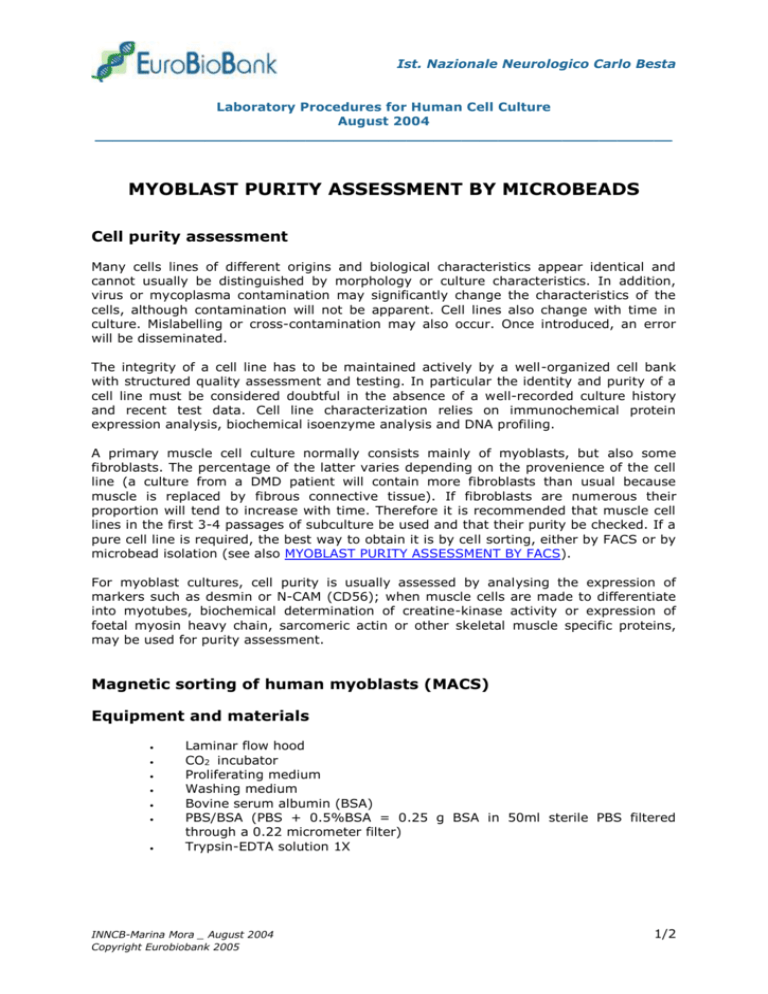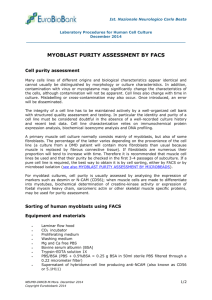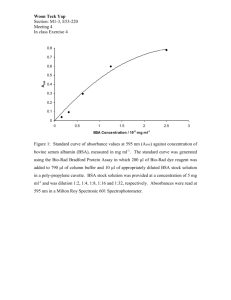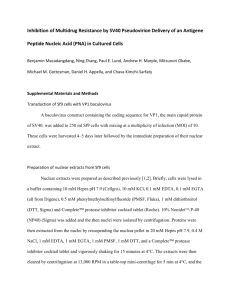Myoblast purity assessment by microbeads
advertisement

Ist. Nazionale Neurologico Carlo Besta Laboratory Procedures for Human Cell Culture August 2004 _______________________________________________________________ MYOBLAST PURITY ASSESSMENT BY MICROBEADS Cell purity assessment Many cells lines of different origins and biological characteristics appear identical and cannot usually be distinguished by morphology or culture characteristics. In addition, virus or mycoplasma contamination may significantly change the characteristics of the cells, although contamination will not be apparent. Cell lines also change with time in culture. Mislabelling or cross-contamination may also occur. Once introduced, an error will be disseminated. The integrity of a cell line has to be maintained actively by a well-organized cell bank with structured quality assessment and testing. In particular the identity and purity of a cell line must be considered doubtful in the absence of a well-recorded culture history and recent test data. Cell line characterization relies on immunochemical protein expression analysis, biochemical isoenzyme analysis and DNA profiling. A primary muscle cell culture normally consists mainly of myoblasts, but also some fibroblasts. The percentage of the latter varies depending on the provenience of the cell line (a culture from a DMD patient will contain more fibroblasts than usual because muscle is replaced by fibrous connective tissue). If fibroblasts are numerous their proportion will tend to increase with time. Therefore it is recommended that muscle cell lines in the first 3-4 passages of subculture be used and that their purity be checked. If a pure cell line is required, the best way to obtain it is by cell sorting, either by FACS or by microbead isolation (see also MYOBLAST PURITY ASSESSMENT BY FACS). For myoblast cultures, cell purity is usually assessed by analysing the expression of markers such as desmin or N-CAM (CD56); when muscle cells are made to differentiate into myotubes, biochemical determination of creatine-kinase activity or expression of foetal myosin heavy chain, sarcomeric actin or other skeletal muscle specific proteins, may be used for purity assessment. Magnetic sorting of human myoblasts (MACS) Equipment and materials Laminar flow hood CO2 incubator Proliferating medium Washing medium Bovine serum albumin (BSA) PBS/BSA (PBS + 0.5%BSA = 0.25 g BSA in 50ml sterile PBS filtered through a 0.22 micrometer filter) Trypsin-EDTA solution 1X INNCB-Marina Mora _ August 2004 Copyright Eurobiobank 2005 1/2 Ist. Nazionale Neurologico Carlo Besta Myoblast purity assessment by microbeads ______________________________________________________________ Supernatant of hybridoma-cell line producing anti-NCAM (also known as CD56 or 5.1H11, available from Hanns Lochmüller, MTCC, München *). Petri dishes 100 mm Rat anti-mouse IgG-conjugated microbeads MACS (Magnetic Cell Sorting) apparatus. Washing Medium DMEM Foetal Bovine Serum Gentamicin (50 microg/ml) Filter and store at +4°C, up to 1 month. 500 ml 50 ml 0.4 ml SGM Proliferating medium Commercial medium (Promocell) for muscle cell culture Supplement Mix (sold with SGM, to be stored as aliquots at - 20°C) Foetal bovine serum Gentamicin (50 mg/ml) (40 microg/ml final) Glutamax 100 X (to be stored as aliquots at - 20°C). Store at +4°C, 10-15 days maximum. 500 ml 25 ml 50 ml 0.4 ml 7.5 ml Procedure 1. Trypsinize cells (ca. 70% confluent) in a 100mm dish, rinse with 8 ml washing medium and centrifuge for 5 min. at about 500g. 2. Discard the supernatant and re-suspend the pellet in 1 ml of PBS/BSA. 3. Transfer suspension (1 ml) to 2 ml Eppendorf tube. Spin at 4°C, 500g for 5 min. Discard the supernatant and re-suspend the pellet in 1ml PBS/BSA. 4. Add 100 µl supernatant of anti-NCAM producing hybridoma-cell line, mix and incubate in the dark on ice with gentle shaking for 45 min. After 45min, spin the tube for 5 min at 4°C and 500g. 5. Wash pellet 3x with 1 ml PBS/BSA and with re-centrifugation. 6. Re-suspend the pellet in 160 microliter PBS/BSA. 7. Add 40 microliter rat anti-mouse IgG1 with microbeads, mix and incubate in the dark on ice for 15 min, preferably on a shaker. 8. Spin tube and re-suspend pellet in 500 microliter PBS/BSA 9. Attach the miniMACS magnet to the miniMACS stand. Attach MACS-column to the magnet and equilibrate the column with 500 microliter PBS/BSA, discarding effluent. 10. Transfer the cell suspension to the column, allow it to run through and collect in a 100 mm dish (MACS (-) dish (= negative fraction with fibroblasts)). Wash the column 2 - 3 times with 500 microliter PBS/BSA and collect the effluent in the MACS (-) dish. 11. Disconnect the column from the magnet, add 1 ml PBS/BSA and flush out the positive fraction into the 100 mm dish MACS (+) dish, exerting gentle pressure with the plunger supplied. 12. Add 10 ml SMG medium to the 100 mm dish MACS (+) dish, and allow cells to grow in a CO2 incubator. * mtcc@fbs.med.uni-muenchen.de INNCB-Marina Mora – August 2004 Copyright Eurobiobank 2005 2/2





